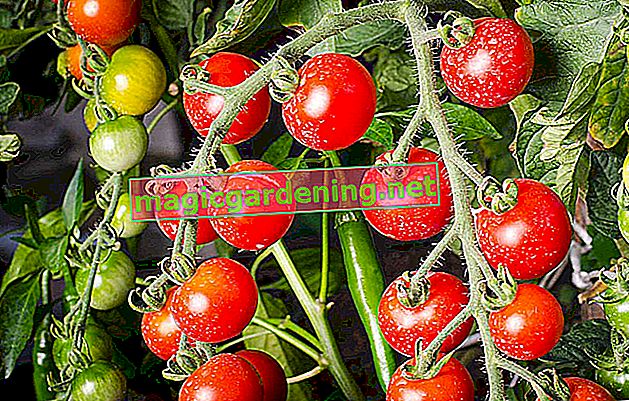
Climbing aids in stick form
Tomato plants have no organs of attachment. So that the tendrils climb up and do not grow lying down on the ground, they are fixed to sticks with wire, raffia, string or clamps. The uncomplicated use is advantageous. The only thing you have to do is put the plant sticks deep enough into the ground so that they don't wobble. The climbing aids should also withstand the cumulative weight in the course of growth. These plant sticks are suitable:
- Bamboo tubes with a thickness of 15 millimeters or more
- Plastic tomato sticks, at least 20 millimeters thick
- Wooden sticks made of oak or larch, approx. 30 millimeters thick
- Steel pipes with structured PE coating
also read
- Growing tomatoes correctly - constructive tips & tricks
- Pour tomatoes properly - so often, so much - tips and tricks
- What temperatures do tomatoes need for their growth?
Under the support rods for tomatoes, spiral rods score with a particularly effective stabilization of the tendrils. Thanks to the sinuous shape made of galvanized steel, they can be reused for many years. Low-growing tomato varieties do not have to be tied here as long as they are regularly exhausted.
Trellis and ranch tower for tomatoes in a planter
If you grow your tomatoes in a pot or flower box (€ 13.18 at Amazon *) on the balcony, you won't be without a practical climbing aid for the tendrils. The garden trade has an abundance of trellises, pyramids, obelisks and towers. The constructions not only serve as a useful climbing aid, but also offer a decorative appearance. Good to know that most models can also be retrofitted.
If you don't want to deal with the topic of climbing aids in the first place, simply plant the tomatoes in a traffic light. Choose hanging tomatoes with small fruits and snack on them all summer long as you go by.
Build a climbing aid for tomatoes in the bed and in the greenhouse yourself
Cost-conscious hobby gardeners do not invest in a finished trellis, but simply build them themselves in the bed or greenhouse. To do this, they use the struts of the roof structure in the greenhouse. In the open air, stable wooden posts are hammered into the ground at the ends of the beds. Small support posts that are screwed on at a 45 degree angle protect against wind throws. The further procedure is the same for both variants:
- Tension a solid wire about 2 meters high
- Tie ropes to it, adjusted to the distance between the tomato plants
- tie the lower end of the rope below the first pair of blades
Each individual rope thus functions as a climbing aid in that the main drive is guided up it in turns. Broad bast ribbon, soft sisal cords, Velcro fasteners, gauze bandages or old clothes cut into strips serve as binding material. It is important to note that the materials do not cut into the tomato shoots.
Tips & Tricks
Reusable climbing aids are dangerous breeding grounds for viruses, fungal spores and pests. It is therefore essential to carefully disinfect them before each use. Otherwise, dreaded diseases suddenly strike, like brown rot.








